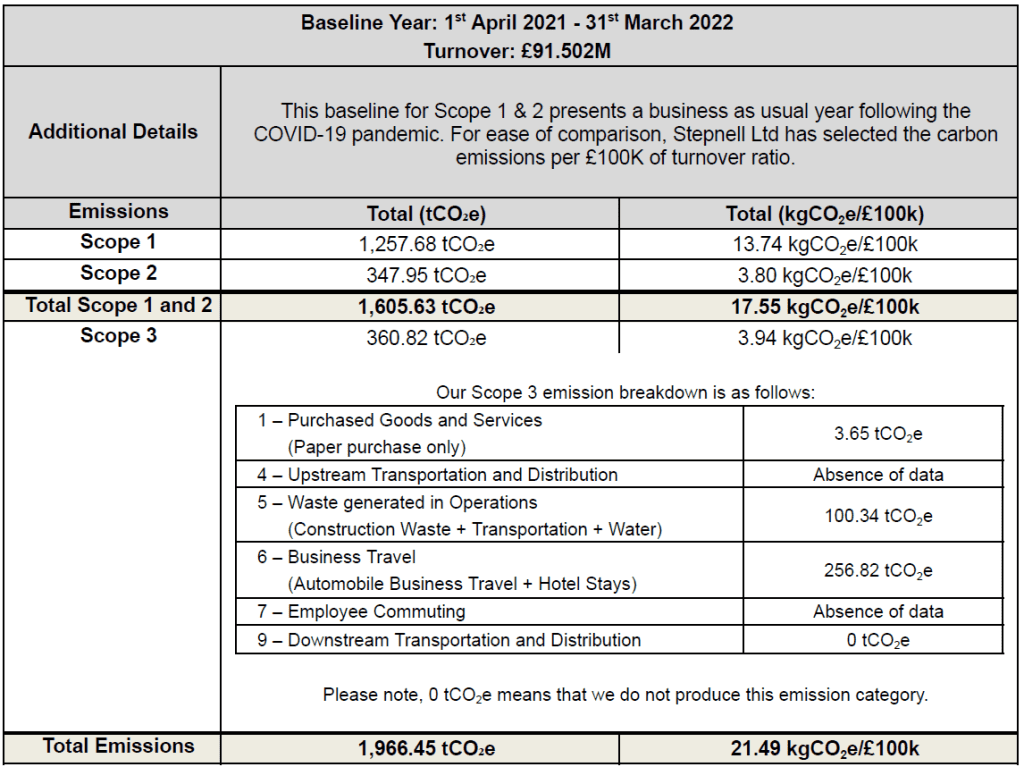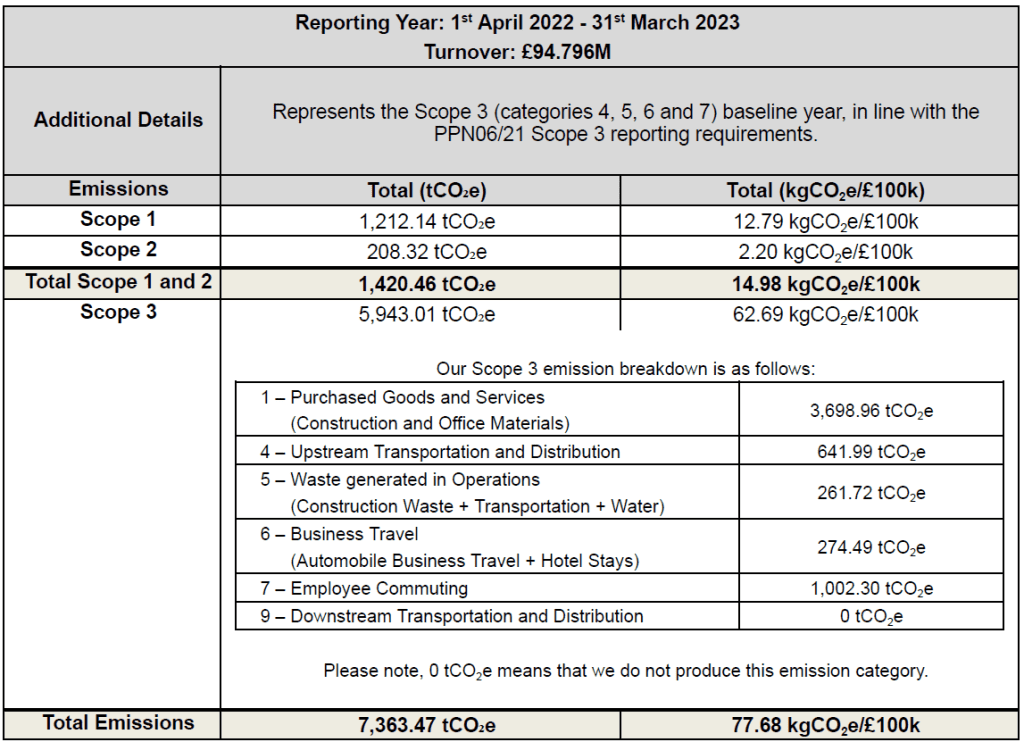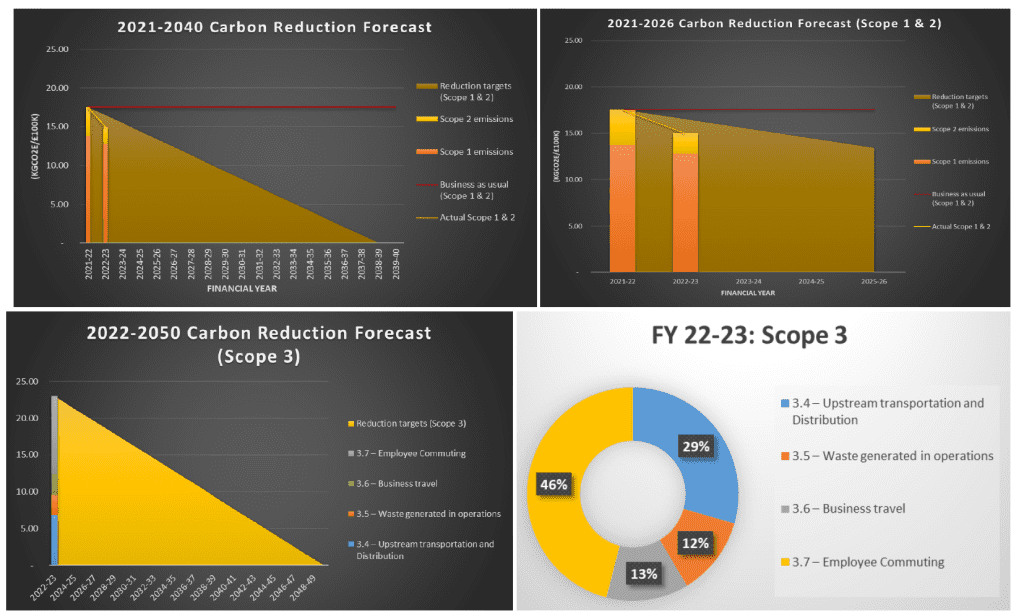Stepnell Ltd is committed to achieving Net Zero emissions by 2050.
We will achieve Net Zero for Scope 1 and 2 by 2039 and we will achieve Net Zero across our value chain carbon (Scope 3) by 2050.
Baseline Emissions Footprint
Baseline emissions are a record of the greenhouse gases that have been produced in the past and were produced prior to the introduction of any strategies to reduce emissions. Baseline emissions are the reference point against which emissions reduction can be measured. The data is obtained from the Streamlined Energy & Carbon Reporting Regulations (SECR) reports.

Downstream transportation and distribution is not relevant to Stepnell Ltd as there is no transportation or distribution associated with the assets delivered.
During the financial year 2022-2023, we developed and introduced new reporting processes and improved data collection to capture our emissions, notably categories 4, 5 and 7 of Scope 3. Our Scope 3 baseline year is therefore aligned to the financial year 2022-2023 (1st April 2022 – 31st March 2023). Please refer to the table below.
Current Emissions Reporting
For ease of comparison Stepnell has selected the carbon emissions per £100K of turnover ratio.

Downstream transportation and distribution is not relevant to Stepnell Ltd as there is no transportation or distribution associated with the assets delivered.
Category 3: Fuel and Energy Use, has also been calculated and is included in the total Scope 3 figure.
Emissions Reduction Targets
In order to continue our progress to achieving Net Zero, we have adopted the following carbon reduction targets.
We project that carbon emissions from Scope 1 and 2 will decrease over the next five years to 13.42 kgCO ₂ e/£100K by 2026. This is a reduction of 23.53% from our baseline year 2021-2022.
Additionally, we project a 2.56 kgCO ₂ e/£100K reduction of the carbon emissions from the five subset Scope 3 emission categories which are upstream transportation and distribution, waste generated in operations, business travel, employee commuting and downstream transportation and distribution by 2026. This is a reduction of 11% from our baseline year 2022-2023.
We will focus on reducing energy consumption, improving energy efficiency, implementing renewable energy and fuel options, and reducing the need to offset, to achieve Scope 1 and 2 Net Zero by 2039 and Scope 3 Net Zero
by 2050.
Progress against these targets can be seen in the graph below:

Carbon Reduction Projects
Completed Carbon Reduction Initiatives
The following environmental management measures and projects have been completed or implemented since the 2021-2022 baseline. The carbon emission reduction achieved by these schemes equate to 2.56 kgCO 2 e/£100k, a 14.6% reduction against the 2021-2022 baseline and the measures will be in effect when performing the contract.
Implemented carbon reduction projects include:
● Certification to ISO14001 Environmental Management.
● Virtualisation of our entire server estate, which has reduced our overall power consumption by 70%.
● Use of Google Workspace, which operates in a carbon neutral cloud environment.
● Stepnell signed up to the “ Contractors Declare ” pledge.
● All sites continue to source materials from sustainable sources wherever possible, such as timber certified by the Forest Stewardship Council (FSC).
● Supply Chain reviews carried out to assess the efficient use of resources, embodied energy of materials used, maximum potential for re-use and recycling at the deconstruction stage.
● Data collection and accuracy improvements through use of SmartWaste, Biosite and Selenity.
● Two hybrid vehicles per competence group have been added to the company car list.
● The Agile Working Policy, which empowers employees with flexibility in when, where and how they work.
● E.ON, our selected energy provider, supplies our offices with 100% renewable electricity.
● Introduction of Smart Grid PVs and battery array to our assets, i.e. Stepnell Park.
Future Carbon Reduction Projects:
Strategic:
● Certification to ISO50001 Energy Management Systems.
● Implement PAS 2060.
● Commit to a Science-Based Target from Science Based Target Initiative (SBTi).
● Launch of Step Energy, our dedicated Energy & Renewables team.
● Increase the number of hybrid vehicles.
● Trial electric vehicles.
● A Cycle to Work Scheme.
● A Paper and Print Reduction Plan.
● Data collection platforms to highlight the impact of our operations and the carbon produced i.e. printing.
● Capture supply chain emissions and favour suppliers which have a Net Zero Carbon Reduction Plan.
● Work with Supply Chains to reduce the embodied carbon of products offered to clients.
● Work with our Stakeholders and with Lincoln University to produce carbon neutral buildings both in terms of embodied carbon and operational carbon.
● Provide an embodied carbon figure for a building on handover, which will include carbon from all sources that have been emitted in delivering a particular project.
Energy Management:
● Employees are asked to carry out their employees’ personal carbon footprint calculations.
● Plant and Vehicle Department to trial PV on top of our site office cabins.
● Use efficient and intelligent temporary lighting and electrical supplies on projects.
● Installation of energy improvements on all company owned welfare units.
● Installation of temporary meters on the construction sites to measure utilities.
● Improve the EPC rating of the head office.
● Installation of LED lighting and lighting upgrades across the offices.
● Reduce use of diesel generators in favour of a renewable or eco-fuel powered generator.
Declaration and Sign Off
This Carbon Reduction Plan has been completed in accordance with PPN 06/21 and associated guidance and reporting standard for Carbon Reduction Plans.
Emissions have been reported and recorded in accordance with the published reporting standard for Carbon Reduction Plans and the GHG Reporting Protocol corporate standard 1 and uses the appropriate Government emission conversion factors for greenhouse gas company reporting 2 .
Scope 1 and Scope 2 emissions have been reported in accordance with SECR requirements, and the required subset of Scope 3 emissions have been reported in accordance with the published reporting standard for Carbon Reduction Plans and the Corporate Value Chain (Scope 3) Standard 3 .
This Carbon Reduction Plan has been reviewed and signed off by the Board of Directors.

1 https://ghgprotocol.org/corporate-standard
2 https://www.gov.uk/government/collections/government-conversion-factors-for-company-reporting
